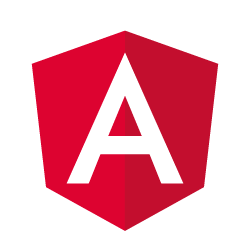We aim to misbehave
Evergreen: Progressive Web App
Dan Scott, Laurentian University
2017 Evergreen International Conference
2017-04-07
Everyone wants an app
- Offline access! Part of my device!
- But apps take time to develop:
- iOS vs. Android vs. Android vs. Android
- Half of US users download 0 apps per month
- Finding the right app can be hard
- App install banners can be annoying
- 24% of people abandon an app after one use (Localytics, 2017-03-30)
Let's improve the web app we have
Y'all got on this boat for different reasons, but y'all come to the same place. So now I'm asking more of you than I have before. Maybe all. Sure as I know anything, I know this - they will try again. […] They'll swing back to the belief that they can make [native apps]… better. And I do not hold to that. So no more runnin'. I aim to misbehave. Serenity, performance by Nathan Fillion, 2005-09-30.
Progressive Web Apps are... what?
From graceful degradation to progressive enhancement
Progressive Web Apps (PWAs)
- Baseline - make web apps more like native apps:
- Responsive: UI adapts to different devices
- Fast to load and render
- Secure: encrypted by HTTPS
- Reliable under any network condition
- Installable to your device home screen
Progressive Web Apps (PWAs)
- Usually built on frameworks like
![Angular]() or
or - Common model: app shell built with templated HTML, minified CSS and JavaScript, with REST calls to JSON data
- Recent example: Mobile Twitter (2017-04-06)
- Almost like the JSPAC of yore…
![Template Toolkit]() Let's see what we can do with the TPAC
Let's see what we can do with the TPAC
Auditing PWA progress
- Lighthouse audits web apps for quality
- Focused on PWA baseline criteria
- Offers advice for exemplary PWAs as well
- Chrome extension & command line tool
Baseline: 37/100
- Fresh Evergreen 2.12 install, without HTTPS
- Praised for:
- Page load performance is fast
- Site is progressively enhanced
- Design is mobile-friendly
Baseline: 37/100
- Fresh Evergreen 2.12 install, without HTTPS
- Punished for:
- Network connection is not encrypted
- User will not be prompted to Add to Homescreen
- Installed web app will not launch with a splash screen
- Address bar will just be default colour
- App can't handle offline/flaky connections
Let's encrypt that connection
- Use
certbotto get a free TLS certificate from LetsEncrypt - Point the Apache config at the certificates
- Enable TLS for all connections
certbot certonly --webroot -w /openils/var/web/ \
-d shiny.example.orgvim /etc/apache2/sites-enabled/eg.conf
SSLCertificateFile /etc/letsencrypt/live/shiny.example.org/fullchain.pem
SSLCertificateKeyFile /etc/letsencrypt/live/shiny.example.org/privkey.pemvim /etc/apache2/eg_vhost.conf
# Uncomment the following to force SSL for everything.
# Note that this defeats caching and you will suffer
# a performance hit.
RewriteCond %{HTTPS} off
RewriteRule ^ https://%{HTTP_HOST}%{REQUEST_URI} [NE,R,L]Baseline with HTTPS: 50/100
Zoë: We mentioned that we were out of rations, and 10 minutes later, a bunch of apples rained into the trench.
Wash: And they grew into a big tree, and they all climbed up the tree into a magical land with unicorns and a harp. "War Stories." Firefly, performance by Gina Torres and Alan Tudyk, season 1, episode 9, 2002-12-06.
Manifest destiny
The purpose of the manifest is to install web applications to the homescreen of a device, providing users with quicker access and a richer experience. "Web App Manifest." Mozilla Developer Network
Manifest basics
- A JSON file with metadata about the web app
- A link to the manifest from the
<head>
{
"short_name": "Shiny Cap'n",
"name": "Shiny Cap'n",
"description": "A real shiny public catalogue!",
"start_url": "/eg/opac/home"
}<link rel="manifest" href="/manifest.json" />Manifest icons
Multiple icons for multiple screen densities
{
"short_name": "Shiny Cap'n",
"icons": [{
"src": "/images/icon48.png", "type": "image/png",
"sizes": "48x48"
},
{
"src": "/images/icon96.png", "type": "image/png",
"sizes": "96x96"
},
{
"src": "/images/icon192.png", "type": "image/png",
"sizes": "192x192"
}],
}Manifest theming
While the app launches, give it nice colours
{
"short_name": "Shiny Cap'n",
"background_color": "#007a54",
"theme_color": "#007a54",
}Manifest display
- When the app launches, set
displayto either:- Hide all user agent chrome: fullscreen
- Launch as a separate application: standalone
- Set
orientationto either portrait or landscape
{
"short_name": "Shiny Cap'n",
"display": "standalone",
"orientation": "portrait"
}link and meta matching
<head> should contain
<link rel="icon" /> and
<meta rel="theme-color" /> elements
that match the manifest values:
<meta rel="theme-color" value="#007a54" />
<link rel="icon" sizes="192x192" href="images/icon192.png" />
HTTPS + manifest: 85/100
'Yes. Yes, this is a fertile land, and we will thrive. We will rule over all this land, and we will call it… "This Land."' "Serenity." Firefly, performance by Alan Tudyk, season 1, episode 1, 2002-09-20. Netflix, https://www.netflix.com/watch/70133870?trackId=200257859.
Optimizations
/eg/opac/homefirst paint: 1648.1ms…opac/home (shiny) …opac/semiauto.css (shiny) - 719.2ms, 14.61KB …opac/simple.js (shiny) - 796ms, 16.4KB …tundra/tundra.css (shiny) - 1,060.6ms, 54.93KB …css/style.css (shiny) - 1,175.7ms, 60.35KB …dojo/openils_dojo.js (shiny) - 1,456.5ms, 12.82KB …opensrf/JSON_v1.js (shiny) - 1,541.4ms, 15.97KB …opensrf/opensrf_xhr.js (shiny) - 1,571.1ms, 17.78KB …themes/dijit.css (shiny) - 1,640.9ms, 36.78KB …images/small_logo.png (shiny) - 1,747.4ms, 15.37KB …opensrf/opensrf.js (shiny) - 1,840.6ms, 39.31KB …images/eg_tiny_logo.png (shiny) - 1,926.7ms, 14.96KB …images/main_logo.png (shiny) - 1,941.4ms, 21.25KB …dojo/dojo.js (shiny) - 2,106ms, 92.59KB
Dojo?!? Didn't we try to avoid Dojo?
Kaylee: Everything's shiny, Cap'n. Not to fret.
Mal: You told me those entry couplings would hold for another week!
Kaylee: That was six months ago, Cap'n. Serenity, performances by Jewel Staite and Nathan Fillion, 2005-09-30.
opac/parts/header.tt2
# Dojo is required to use the copy locations advanced search
# filter, therefore, it should always be enabled.
want_dojo = 1;
IF use_autosuggest.enabled == "t";
want_dojo = 1;
END;
IF ctx.google_books_preview;
want_dojo = 1;
END;
IF ENV.OILS_NOVELIST_URL;
want_dojo = 1;
END;
The fix is in bug 1411699
…opac/home (shiny)
…opac/semiauto.css (shiny) - 592ms, 11.48KB
…opac/simple.js (shiny) - 642.3ms, 13.26KB
…css/style.css (shiny) - 862.8ms, 58.53KB
…images/eg_tiny_logo.png (shiny) - 1,041.5ms, 11.82KB
…images/main_logo.png (shiny) - 1,071.5ms, 18.12KB- Still 85/100 , but first paint is down to 1011.9ms!
- Most of the points are docked because we fail the App can load on offline/flaky connections test
Are we the Serenity?
Kept in the air by love (and Kaylee)
Or are we a Reaver Ship?
Belching smoke and uncontained radiation...
and Dojo 1.3
Handling offline/flaky connections:
Introducing service workers
Service workers
- A separate JavaScript per origin scope
- Runs on a separate thread
- No access to the DOM
- Can intercept and modify network requests for fine-grained caching strategies
- Enables push notifications, too!
Service worker support
- Supported by Chrome, Firefox, Opera today
- Microsoft Edge is working on it
- Safari… 🤷
- But progressive enhancement means it's okay!
Service worker registration
<script>
if ('serviceWorker' in navigator) {
window.addEventListener('load', function() {
// Your service worker *must* be located at
// the top-level directory relative to your site.
// It won't be able to control pages unless it's
// located at the same level or higher than them.
navigator.serviceWorker.register('/sw.js')
.then(function(reg) { /* … stuff! */ })
.catch(function(e) { console.error('Error:', e); });
}
}
</script>Service worker: Fetch API
Let there be patterns!
serviceworke.rs offers examples of caching strategies
Network-or-cache
self.addEventListener('fetch', function(evt) {
if evt.respondWith(fromNetwork(evt.request, 400)
.catch(function () {
return fromCache(evt.request);
}));
});
function fromNetwork(request, timeout) {
return new Promise(function (fulfill, reject) {
var timeoutId = setTimeout(reject, timeout);
fetch(request).then(function (response) {
clearTimeout(timeoutId);
fulfill(response);
}, reject);
});
}Cache and update
self.addEventListener('fetch', function(evt) {
evt.respondWith(fromCache(evt.request));
evt.waitUntil(update(evt.request));
});
function fromCache(request) {
return caches.open(CACHE).then(function (cache) {
return cache.match(request).then(function (matching) {
return matching || Promise.reject('no-match');
});
});
}
function update(request) {
return caches.open(CACHE).then(function (cache) {
return fetch(request).then(function (response) {
return cache.put(request, response);
});
});
}Let there be tools!
- We could roll our own service worker based on the serviceworke.rs patterns
- But libraries provide a nice layer of abstraction:
- sw-toolbox implements network handlers with five request/caching patterns
- sw-precache builds on
sw-toolboxto generate a service worker based on a configuration file
package.json
{
"name": "evergreen-pwa-stuff",
"version": "1.0.0",
"description": "Evergreen PWA stuff",
"author": "Dan Scott",
"license": "GPL-2.0+",
"dependencies": {
"sw-precache": ">4.3.0"
}
}$ npm installsw-precache basic dumb config
module.exports = {
staticFileGlobs: [
'/openils/var/web/css/skin/default/opac/semiauto.css',
'/openils/var/web/js/ui/default/opac/simple.js',
'/openils/var/web/opac/images/small_logo.png',
'/openils/var/web/opac/images/progressbar_green.png',
'/openils/var/web/opac/images/main_logo.png',
'/openils/var/web/opac/images/eg_tiny_logo.png'
],
stripPrefix: '/openils/var/web/',
runtimeCaching: [{
urlPattern: /^https:\/\/shiny.example.org\//,
handler: 'networkFirst'
}]
};Enable our service worker
- Generate and install the service worker
- Install the boilerplate registration code
- Add registration code to
templates/opac/parts/base.tt2
$ node_modules/sw-precache/cli.js --config sw-precache.js
Total precache size is about 18.2 kB for 6 resources.
service-worker.js has been generated.
$ cp service-worker.js /openils/var/web/sw.js
$ cp sw-register.js /openils/var/web/.
HTTPS + manifest + service worker: 100/100
Shut. Up.
100/100 PWA score!*
- Specifically, no My Account pages are available offline
- That was kind of the point of the exercise
*Score may not reflect real-world experiences
"My Account" headers
cache-control: no-store, no-cache, must-revalidate
expires: -1
no-storemeans "never cache this"expires: -1means "this expires immediately"- No network connection? You shall not see your checked out items!
Radical surgery
diff --git a/Open-ILS/src/perlmods/lib/OpenILS/WWW/EGCatLoader.pm b/Open-ILS/src/perlmods/lib/OpenILS/WWW/EGCatLoader.pm
index 6aa1f58..6548edc 100644
--- a/Open-ILS/src/perlmods/lib/OpenILS/WWW/EGCatLoader.pm
+++ b/Open-ILS/src/perlmods/lib/OpenILS/WWW/EGCatLoader.pm
@@ -184,8 +184,7 @@ sub load {
return $self->redirect_auth unless $self->editor->requestor;
# Don't cache anything requiring auth for security reasons
-$self->apache->headers_out->add("cache-control" => "no-store, no-cache, must-revalidate");
-$self->apache->headers_out->add("expires" => "-1");
+$self->apache->headers_out->add("cache-control" => "no-cache, must-revalidate");
return $self->load_email_record if $path =~ m|opac/record/email|;
Rapid decay
If we remove those headers, Expires becomes + 5 seconds due to /etc/apache2/eg_vhost.conf:
<Location /eg/opac>
PerlSetVar OILSWebContextLoader "OpenILS::WWW::EGCatLoader"
# Expire the HTML quickly since we're loading dynamic data
ExpiresActive On
ExpiresByType text/html "access plus 5 seconds"
</Location>
It's dynamic, but there are alternatives to Expires
Enter ETag
diff --git a/Open-ILS/src/perlmods/lib/OpenILS/WWW/EGWeb.pm b/Open-ILS/src/perlmods/lib/OpenILS/WWW/EGWeb.pm
index da18d7e..21d4715 100644
--- a/Open-ILS/src/perlmods/lib/OpenILS/WWW/EGWeb.pm
+++ b/Open-ILS/src/perlmods/lib/OpenILS/WWW/EGWeb.pm
@@ -129,11 +129,16 @@ sub handler_guts {
$vhost_processor_cache{$processor_key} = $tt;
$ctx->{encode_utf8} = sub {return encode_utf8(shift())};
-unless($tt->process($template, {ctx => $ctx, ENV => \%ENV, l => $text_handler}, $r)) {
+my $_out = '';
+unless($tt->process($template, {ctx => $ctx, ENV => \%ENV, l => $text_handler}, \$_out)) {
$r->log->warn('egweb: template error: ' . $tt->error);
return Apache2::Const::HTTP_INTERNAL_SERVER_ERROR;
}
+my $etag = md5_hex(Encode::encode_utf8($_out);)
+$r->headers_out->add('Etag' => $etag);
+$r->print($_out);
+
return Apache2::Const::OK;
Whither Expires?
- Given
ETagandno-cache, the browser will always make a request to the server - If the server can't respond (is down, or has no network connection), the service worker can
- Bonus: for other HTML pages,
Expirescan be turned off
<Location /eg/opac>
PerlSetVar OILSWebContextLoader "OpenILS::WWW::EGCatLoader"
ExpiresActive Off
</Location>
Add to Home Screen: Shiny!
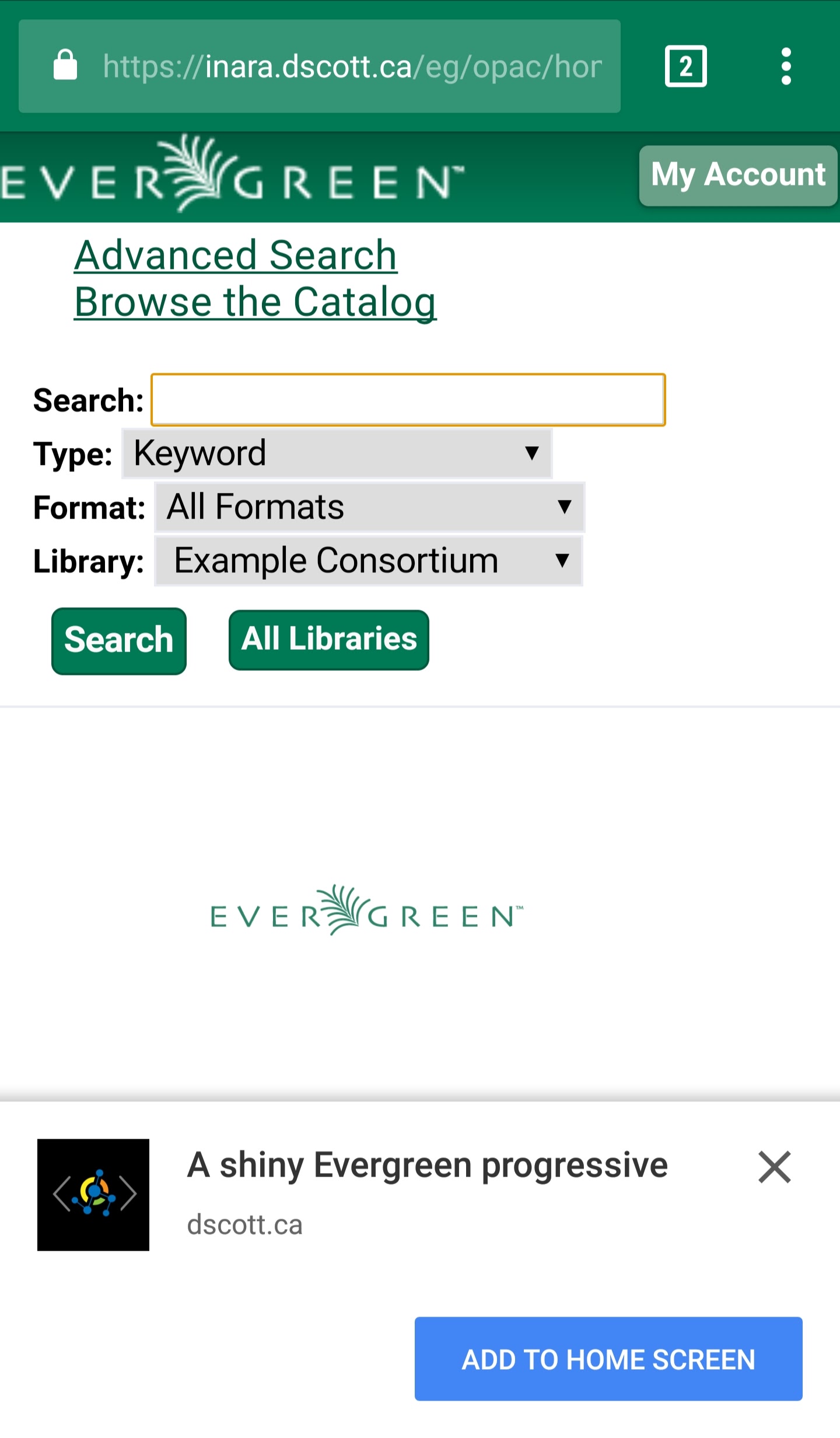
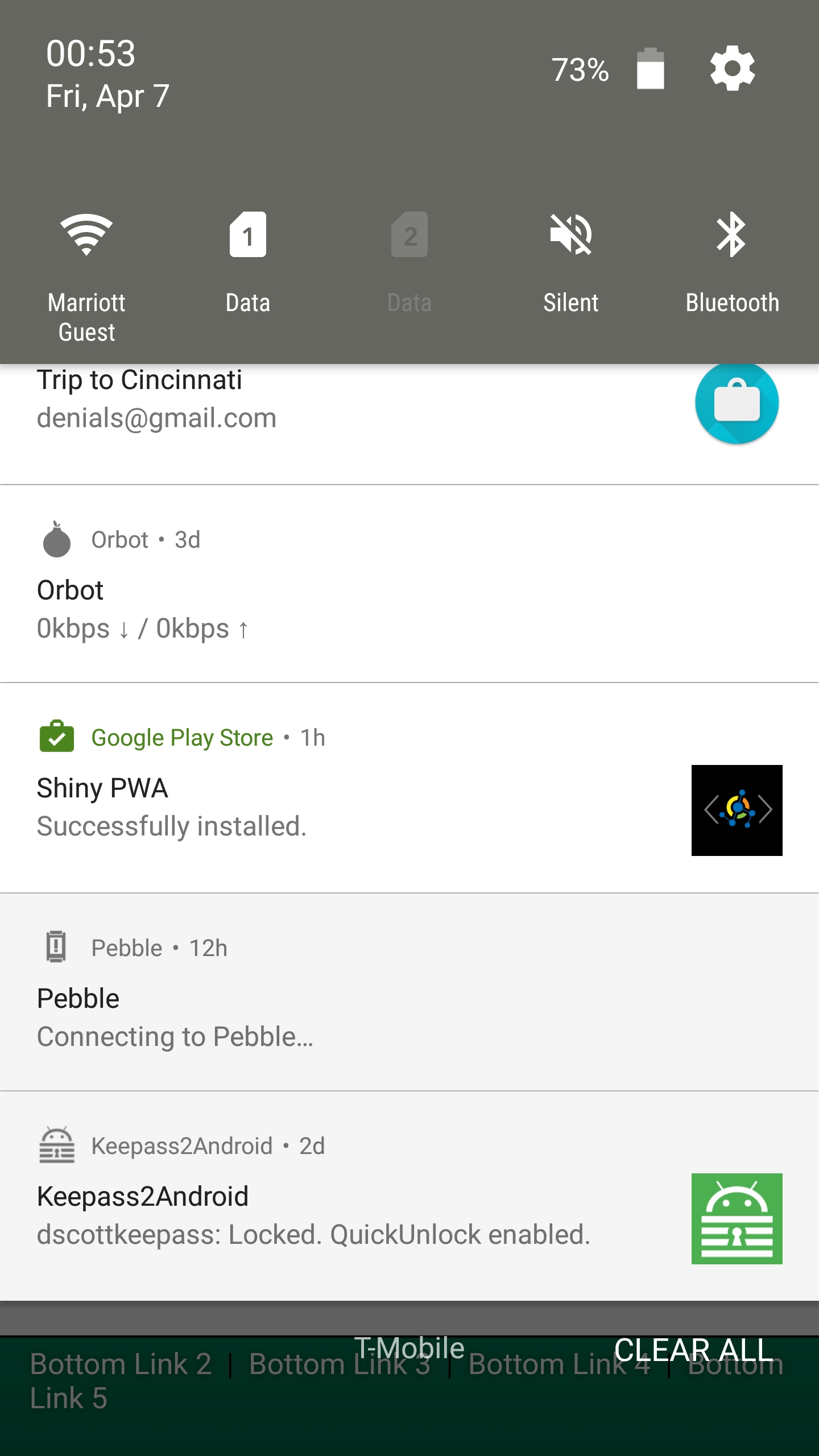
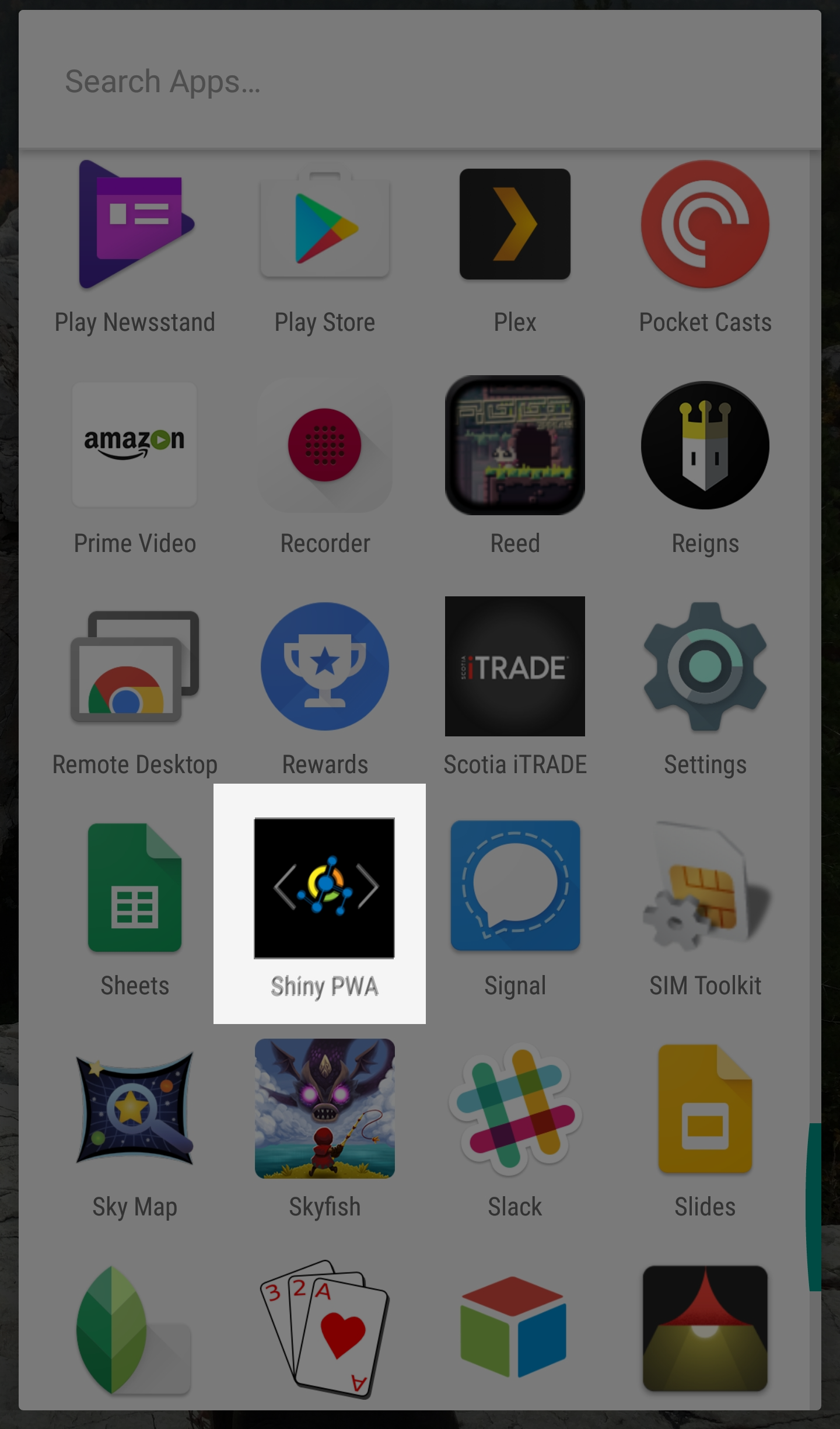

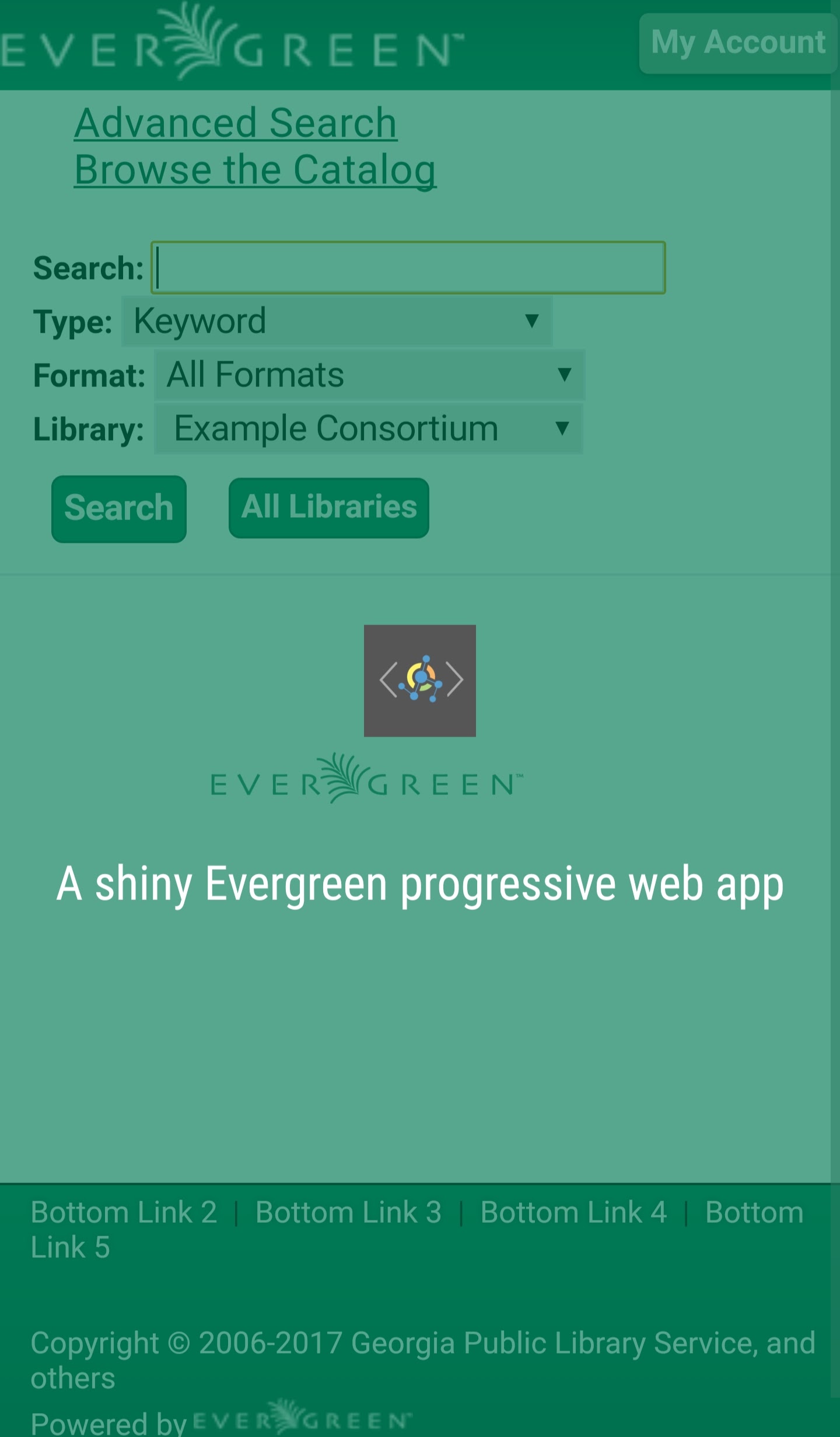
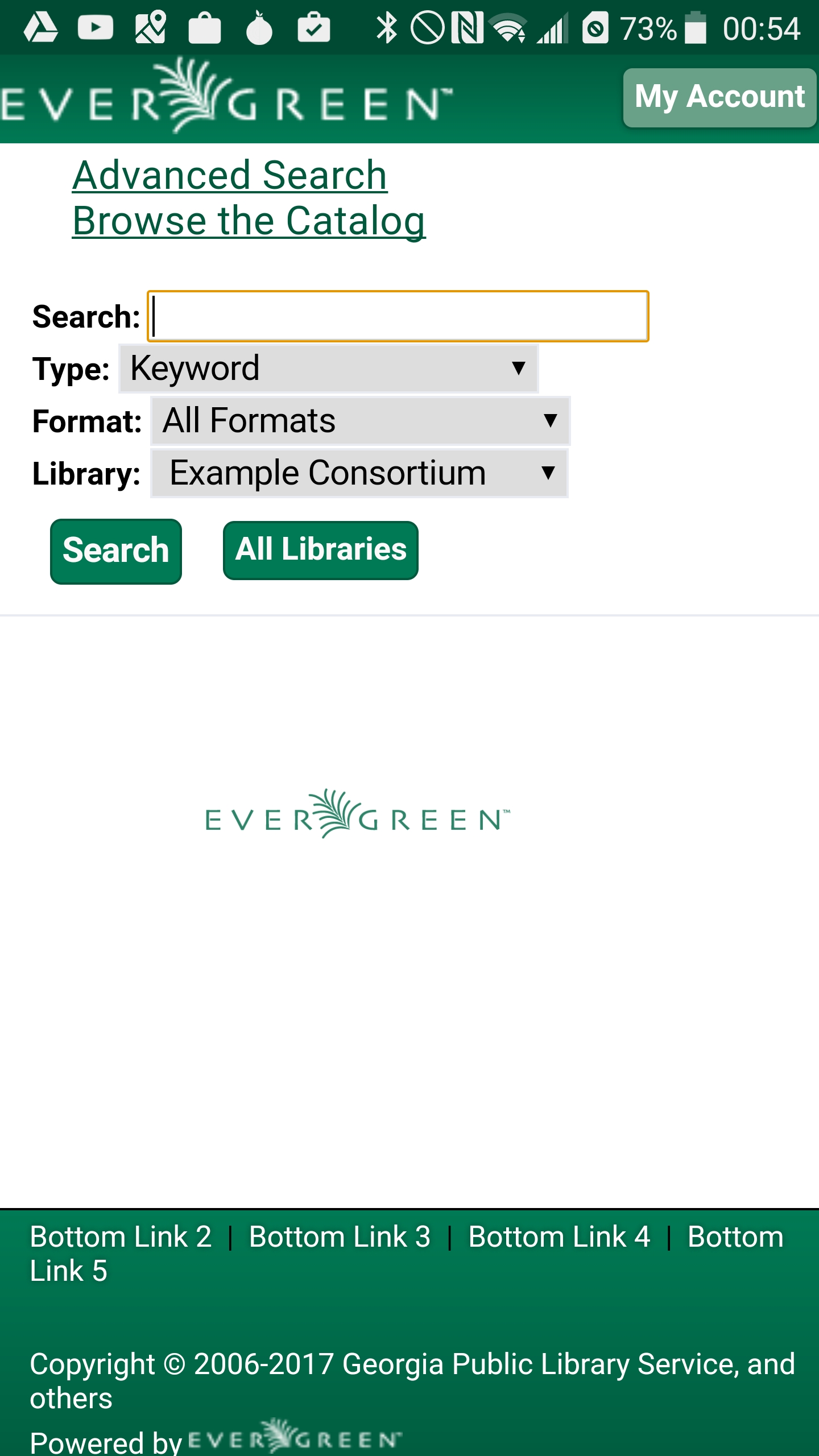
HTTP/2
- Lighthouse recommends using HTTP/2
- One TCP connection multiplexes requests and compresses headers
- More efficient than four to eight separate connections per origin (http2 FAQ)
- Nginx--which we're already using to proxy websockets--supports HTTP/2
- Let's get this thing going
HTTP/2 on Debian Jessie
Jessie doesn't deliver a new enough version, so:
apt-get -t jessie-backports install nginx
HTTP/2: nginx config
diff --git a/examples/nginx/osrf-ws-http-proxy b/examples/nginx/osrf-ws-http-proxy
index d079230..2fbf832 100644
--- a/examples/nginx/osrf-ws-http-proxy
+++ b/examples/nginx/osrf-ws-http-proxy
@@ -19,7 +19,7 @@ server {
}
server {
- listen 443;
+ listen 443 ssl http2;
ssl on;
# Use the same SSL certificate as Apache.
HTTP/2: Are we good?
$ curl --http2 -H "Accept-Encoding: gzip" \
-I https://shiny.example.org/eg/opac/home
HTTP/2 200
server: nginx/1.10.3
date: Sat, 01 Apr 2017 15:44:15 GMT
content-type: text/html; encoding=utf8
etag: 1735fc80e7ea268e656d53ac9126e438
nginx falls back to HTTP 1.1 for browsers that don't support HTTP/2
(Yes, I tested with w3m)
Brain dead approach PWA results
Not bad. Almost ready for prime time!
We've inadvertently enabled the web staff client--yay!?
But we're lacking a few things…
An offline fallback page
- A search-driven app will lead to cache misses
- Ideally, tell the user what they can access (perhaps via History API?)
- This will require custom service worker code
Better control over GET params
- Default behaviour is to treat the following pages as completely different:
https://shiny.example.org/eg/opac/myopac/holds?query=potterhttps://shiny.example.org/eg/opac/myopac/holds?query=harry
- For the
/myopac/pages, at least, GET params shouldn't matter - This will require custom service worker code
Separate the apps
/eg/opac/,/eg/staff/, and/eg/myopac/are conceptually separate apps- But common JS, image, CSS assets under
/require them all to use the same service worker - Instead, use
/eg/opac/assets/,/eg/staff/assets/, and/eg/myopac/assetsto serve up static assets from/openils/var/web/?
A modern /eg/myopac?
- Precache a static app shell
- Load fines, holds, lists, messages, etc as JSON over REST
- Deliver native device notifications with the Push API
I got people with me, people who trust each other, who do for each other and ain't always looking for the advantage. There's good people in the 'verse. Not many, lord knows, but you only need a few. "Our Mrs. Reynolds." Firefly, performance by Nathan Fillion, season 1, episode 3, 2002-10-02.
Details
- Slides: stuff.coffeecode.net/2017/evergreen-progressive-web-app
- Email: dscott@laurentian.ca
- Social: @denials / +DanScottCAN
- Blog: coffeecode.net

This work is licensed under a Creative Commons Attribution-ShareAlike 4.0 International License
